http://earthsky.org/space/this-date-in-science-edwin-hubble-and-the-expanding-universe#.Uozg2rBME0M
Happy Birthday Hubble!
Posted from WordPress for Android via my Samsung smartphone. Please excuse any misspellings. Ciao, Jon
Sunsets, Stars, West, Wind
http://earthsky.org/space/this-date-in-science-edwin-hubble-and-the-expanding-universe#.Uozg2rBME0M
Happy Birthday Hubble!
Posted from WordPress for Android via my Samsung smartphone. Please excuse any misspellings. Ciao, Jon
NASA’s Voyager 1 Explores Final Frontier of Our ‘Solar Bubble’ – NASA Jet Propulsion Laboratory
http://www.jpl.nasa.gov/news/news.php?release=2013-209
To go where no one has gone before.
 Friday turned into a very long day indeed. I took the afternoon off to accompany my husband to a doctor’s visit to discuss the next steps in managing his condition. That appointment went better than I thought it would and I’m grateful for the information and the prospects. We will persevere.
Friday turned into a very long day indeed. I took the afternoon off to accompany my husband to a doctor’s visit to discuss the next steps in managing his condition. That appointment went better than I thought it would and I’m grateful for the information and the prospects. We will persevere.
We got back home with just thirty minutes to spare before venturing out again, this time a couple of miles west of us (on the other side of Lansing) to attend the grand opening of a new farmer’s market. We’ve known the family that owns the farm for years, and we love to buy locally grown produce. We didn’t stay long as I needed to research and prep for the star party at Powell.
I received the ‘all clear’ or ‘go ahead’ e-mail from the ASKC star party coordinator earlier in the afternoon. I called my dad to see if he wanted to join me. He had a conflict so I asked my husband. He preferred to stay home. So I was on my own.
First thing I needed to do was dust off the 8-inch Dob. Then I attempted to collimate it. Then I dialed in the finder scope. I didn’t remember until later that I’d purchased, back in October, a new finder scope, so I missed the opportunity to try it out. The weather forecast for the rest of the weekend doesn’t look good for more testing opportunities.
Next, I found my Astro Quest Observing checklist and started planning my overly ambitious observing list for Friday night’s star party. I’ve been working on this observing award for nearly two years now. I really need to step it up and get it done! I got a bit distracted when I realized I hadn’t recorded some of the observations I made last fall and winter. Eventually, I returned to those items I’ve yet to observe that would be the best candidates for an early June dark-of-the-moon night sky. I used my Pocket Sky Atlas and the Android App SkySafari Plus on my Samsung Galaxy Note II to select twenty items. I added these targets to a list in the app:
I partially disassembled the Dob for transport, placing the tube in its carrying case. I had some concern that the base would not fit in the trunk of my car, but it did, barely. I discovered my portable emergency red light battery needed charging so I plugged it in a couple of hours before I needed to leave. I found a lawn chair and a table I could take. I forgot two items that in hindsight I should have brought with me: 1) the monopod for my binoculars (to reduce shaking while observing) and 2) Deep Woods Off or some other Deet laden bug spray. I got everything into the car, except the charging battery, and watched the clock tick down to 7:30 p.m.
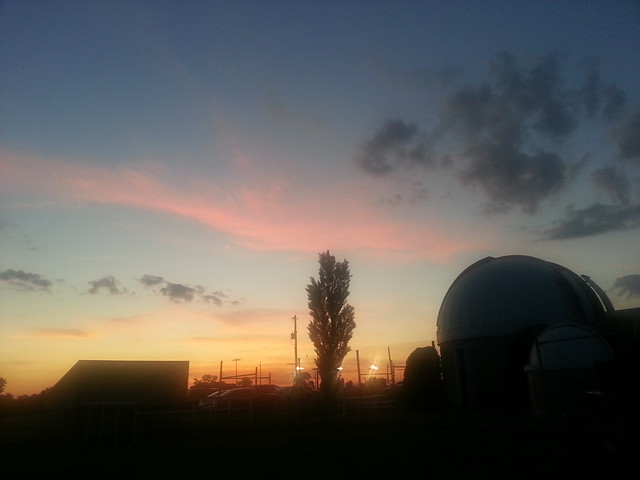 The drive to Powell Observatory near Louisburg took an hour, but I enjoyed listening to my audiobook and dodging Johnson County drivers. I arrived to a gorgeous sunset (see photos above and at right). I also noticed a baseball game in progress to the northwest of the observing field (you can see the field lights already on in the photo above). These lights became an annoyance for the next two hours.
The drive to Powell Observatory near Louisburg took an hour, but I enjoyed listening to my audiobook and dodging Johnson County drivers. I arrived to a gorgeous sunset (see photos above and at right). I also noticed a baseball game in progress to the northwest of the observing field (you can see the field lights already on in the photo above). These lights became an annoyance for the next two hours.
I opted to park in the parking light north of the observatory and across the street. Several ASKC members were already setting up their telescopes east of the dome. The parking lot to the west of the dome was filled with what I assumed to be a private party that had reserved the dome facilities for the evening. It took me three trips to get the telescope and accessories from the car to the observing field. While I made these trips, the star party coordinator informed me I could have driven my car around the dome onto the observing field to make my life easier. But I excel at doing things the hard way. Maybe next month I’ll be lazier.
I put the scope back together and checked the alignment of the finder scope. Then I settled into my lawn chair to wait for darker skies. Eventually, around 9:30 p.m., I got my binoculars out and waited for Venus, Mercury and Saturn to pop out in the twilight. I observed all three of these planets with binoculars and with the 8-inch Dob. I could clearly see that Mercury was half full (or is that more properly referred to as quarter illuminated?).
During this time (after sunset but before the ball field lights were extinguished), we saw the ISS pass over in the northern part of the sky.
I used my binoculars to locate M13 in Hercules and I used the scope to find M4 in Scorpius. I roamed around the sky with my binoculars, relaxing in my lawn chair, getting increasingly annoyed by the brightness of the ball field lights. I also started to notice an accumulation of dew on just about everything. When I would pick up my binoculars and look through them, often I would see bright halos instead of pin pricks of starlight. Any printouts I had sitting on my table quickly became sodden and unusable.
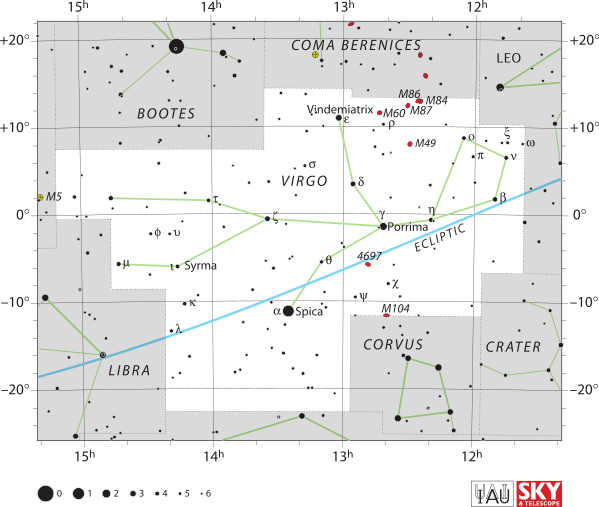 The ballgame finally wrapped up a few minutes before 10:30 p.m. We all cheered when the lights finally died and we could let our eyes adjust to the dark. Within fifteen minutes, I had found the Sombrero Galaxy (aka M 104) in the constellation Virgo. This was my first chance to really field test using SkySafari Plus on my smartphone, using the night vision setting (red display) and the ability to zoom-in to match the field-of-view I saw through my scope’s eyepiece. Made star hopping easier. No more juggling my reading glasses, a red light flashlight and my Pocket Star Atlas. To find the galaxy, I actually came up from the constellation Corvus (see chart above).
The ballgame finally wrapped up a few minutes before 10:30 p.m. We all cheered when the lights finally died and we could let our eyes adjust to the dark. Within fifteen minutes, I had found the Sombrero Galaxy (aka M 104) in the constellation Virgo. This was my first chance to really field test using SkySafari Plus on my smartphone, using the night vision setting (red display) and the ability to zoom-in to match the field-of-view I saw through my scope’s eyepiece. Made star hopping easier. No more juggling my reading glasses, a red light flashlight and my Pocket Star Atlas. To find the galaxy, I actually came up from the constellation Corvus (see chart above).
I had to abandon searching for dim nebula and the harder to find variable stars on my observing list because of the persistent haze that hung over the sky. While I was grateful for the lack of wind, this also resulted in no movement of the thin clouds. I had to focus on brighter objects. I did observe, in my binoculars, the stars Thuban, Adhafera and Sarin, but I did not attempt R CrB or 48 Librae, which require better seeing conditions to locate via star hopping.
 During the eleven o’clock hour, I set my sights on locating M5, a globular cluster, found in the constellation Serpens. I’ve tried a couple of times in the past to locate this cluster, but there are no bright stars near it to guide you to it. Since I’m trying to perfect my star hopping abilities (and didn’t bring my “goto” telescope with me), I again used the SkySafari Plus, zoomed in to with in a couple of degrees of the cluster, to find a suitable path among the faint stars. At first I attempted from the east (my left) using some stars in the Serpens constellation, but I kept getting lost (or nowhere), so I changed tactics and thought I’d try coming ‘up’ from Libra. No luck there either.
During the eleven o’clock hour, I set my sights on locating M5, a globular cluster, found in the constellation Serpens. I’ve tried a couple of times in the past to locate this cluster, but there are no bright stars near it to guide you to it. Since I’m trying to perfect my star hopping abilities (and didn’t bring my “goto” telescope with me), I again used the SkySafari Plus, zoomed in to with in a couple of degrees of the cluster, to find a suitable path among the faint stars. At first I attempted from the east (my left) using some stars in the Serpens constellation, but I kept getting lost (or nowhere), so I changed tactics and thought I’d try coming ‘up’ from Libra. No luck there either.

Finally, I moved to the west, to the right leg of the constellation Virgo, and used stars tau and 109 to draw a line due east (to the left) directly to M5. Huzzah! I found it at 11:30 p.m. I observed the cluster, as best I could with the less than stellar seeing conditions, and sat savoring the triumph of finally locating this illusive globular cluster.
 Several other star party attendees had started packing up their equipment, probably because of the dew and the haze. I wanted to stick it out, at least until midnight, so I quickly scanned through my observing list and decided to investigate the 13th constellation in the Zodiac (or rather, one of the thirteen constellations that cross the ecliptic) and find an open cluster, IC 4665. It should have been visible with binoculars, but I had little hope of that. Ophiuchus, also known as the Serpent Bearer, is a large constellation between Sagittarius and Scorpius. I used the nu and tau stars to guide me to the open cluster. I could see it well (although it barely fit in the field of view) via the scope, but could not discern it through my binoculars, which kept fogging over and became more and more useless as the night progressed.
Several other star party attendees had started packing up their equipment, probably because of the dew and the haze. I wanted to stick it out, at least until midnight, so I quickly scanned through my observing list and decided to investigate the 13th constellation in the Zodiac (or rather, one of the thirteen constellations that cross the ecliptic) and find an open cluster, IC 4665. It should have been visible with binoculars, but I had little hope of that. Ophiuchus, also known as the Serpent Bearer, is a large constellation between Sagittarius and Scorpius. I used the nu and tau stars to guide me to the open cluster. I could see it well (although it barely fit in the field of view) via the scope, but could not discern it through my binoculars, which kept fogging over and became more and more useless as the night progressed.
I still had a few minutes to go before tomorrow arrived, so I turned the scope northward, to Ursa Major, hoping to find the Owl Nebula. Unfortunately, looking north from Powell Observatory means looking back through the entirety of Kansas City and all its glorious star-obscuring light pollution. I made a half-hearted attempt to locate the nebula and decided enough was enough.
I switched on my portable battery and it’s ’emergency’ red light (in non-flashing mode) so I could see my observing site well enough to start packing up the equipment. Everything was soaked in dew. Thank goodness my Pocket Sky Atlas is designed for moisture-laden environments. The paper it’s printed on isn’t traditional paper. I suspect a high content of plastic.
Three trips later, I had everything back in the car. I pulled out of the parking lot at six minutes past midnight and pulled into my driveway an hour later. I went straight to bed.
Final thoughts? I was able to check off three of the twenty items from my observing target list. Not nearly as many as I had hoped to find, but given the conditions, I’m satisfied with the results. I’ll give it another go next month and as I can from my backyard, weather permitting.
 Despite a busy weekend of van maintenance (oil change/tire rotation), hair maintenance (shampoo, cut & style), yard maintenance (leaves, leaves and more leaves and now pine needles), home improvement projects (refinishing lower kitchen cabinets) and exercise (very long walk with Apollo), I squeezed in an hour of star gazing after a night out with Terry and friends at Jack Stack on the Plaza. I’ve been wanting to get the scope out for a couple of weeks now, but the evening skies have not cooperated, remaining hazy at best or completely cloud covered at their worst. Upon parking the car in the driveway Saturday night, I looked up and decided the skies looked good enough to attempt some star gazing. I didn’t even take my purse into the house. I drug the telescope out of the garage and began hunting down more targets on my Astro Quest observing award checklist.
Despite a busy weekend of van maintenance (oil change/tire rotation), hair maintenance (shampoo, cut & style), yard maintenance (leaves, leaves and more leaves and now pine needles), home improvement projects (refinishing lower kitchen cabinets) and exercise (very long walk with Apollo), I squeezed in an hour of star gazing after a night out with Terry and friends at Jack Stack on the Plaza. I’ve been wanting to get the scope out for a couple of weeks now, but the evening skies have not cooperated, remaining hazy at best or completely cloud covered at their worst. Upon parking the car in the driveway Saturday night, I looked up and decided the skies looked good enough to attempt some star gazing. I didn’t even take my purse into the house. I drug the telescope out of the garage and began hunting down more targets on my Astro Quest observing award checklist.
 I did make one trip inside to retrieve my binoculars, pocket star atlas, clipboard and checklist. I used Jupiter to re-align the finderscope and spent several minutes enjoying an interesting moon alignment (see image above).
I did make one trip inside to retrieve my binoculars, pocket star atlas, clipboard and checklist. I used Jupiter to re-align the finderscope and spent several minutes enjoying an interesting moon alignment (see image above).
 Using binoculars, I easily found the Andromeda galaxy and the Double Cluster (between Perseus and Cassiopeia). I checked off two stars from my list, Algol in Perseus and Gamma Cassiopeiae. Since the constellation Pegasus was nearly directly overhead, I went hunting for the Triangulum galaxy, also known as M33. I could barely see the three stars in the constellation Triangulum, but no matter how hard I searched (with binoculars, not naked eye), I could not find this galaxy. I should have been able to trace a line from M31 through two stars in the constellation Andremeda (Mu and Beta Andromedae) to find M33, but I was defeated once again by urban (and prison) light pollution. I had hoped to stumble upon it with binoculars, especially since M31 was so easily visible and found (almost naked eye Saturday night, but not quite).
Using binoculars, I easily found the Andromeda galaxy and the Double Cluster (between Perseus and Cassiopeia). I checked off two stars from my list, Algol in Perseus and Gamma Cassiopeiae. Since the constellation Pegasus was nearly directly overhead, I went hunting for the Triangulum galaxy, also known as M33. I could barely see the three stars in the constellation Triangulum, but no matter how hard I searched (with binoculars, not naked eye), I could not find this galaxy. I should have been able to trace a line from M31 through two stars in the constellation Andremeda (Mu and Beta Andromedae) to find M33, but I was defeated once again by urban (and prison) light pollution. I had hoped to stumble upon it with binoculars, especially since M31 was so easily visible and found (almost naked eye Saturday night, but not quite).
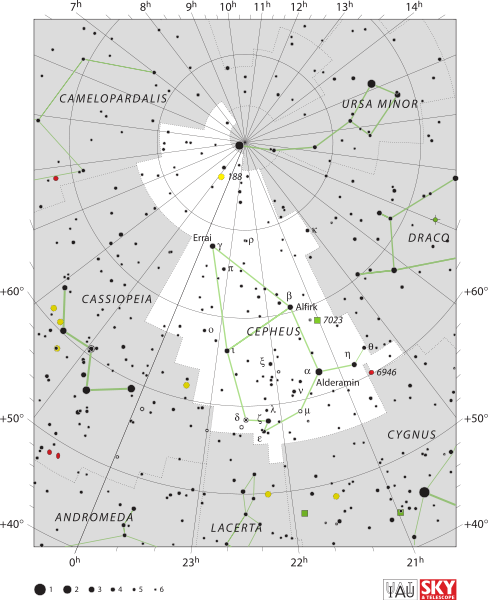
I became more chilled as the evening wore on, neglecting to put on my sweater and just ignoring the 40 degree temperatures. The lack of wind helped shore up my illusion of warmth. I thought I’d try one last object before packing the scope up and returning it to the garage. I went hunting for the Garnet star in the constellation Cepheus. With my naked eyes, I could barely make out some of the stars that form the ‘house’ asterism. I knew the general area to look for Mu Cephei so I aimed my binoculars between the alpha and delta stars. Whoa! Way, way too many stars visible, thanks to the backdrop of our own Milky Way galaxy. Staring again with just my eyes, I squinted against the light pollution, but could still only see some of the anchor stars of Cepheus and no Milky Way stars.
I gave up, because I knew I would need to study several star atlases closely and device a star hop from Alpha Cephei to Mu Cephei, a trail I would need to memorize, so I wouldn’t have to take my reading glasses on and off while attempting to observe.

Another star trail I need to work on is finding M15 in the constellation Pegasus. I really shouldn’t have had any trouble finding M15, since you can draw a nearly strait line from Theta Pegasi through Epsilon Pegasi to point to that globular cluster. Either my skies were not dark enough, or I kept misidentifying Enif (Epsilon Pegasi) in my binoculars.
I couldn’t wait for midnight Friday night. The forecast for the weekend seemed unbelievable, especially after the scorching heat of the last month. Clear skies and mid to lower 80s for the high temperatures over the next several days. I came home from work to a grilled steak and baked potato dinner, prepared by Terry. Mmm-mmm good.
After dinner, Terry and I began reviewing the DVR play list and guide, deciding to delete many old recordings to free up some disc space. Our daughter called and chatted with us for about forty-five minutes. The conversation ended abruptly when her phone battery died.
For dessert, Terry blended a frozen raspberry lemonade. I read for a few minutes, while slowly sipping the drink (trying to avoid a brain freeze). I asked him to wake me up around midnight so I could scout the skies in search of the Andromeda galaxy and the planet Neptune. Apollo followed me upstairs to the bedroom to join me in my nap.
Terry woke me up just shortly after midnight. I rubbed the sleep out of my eyes and found my flip flops. I followed Terry back downstairs to the band room and walked out the patio door to the back yard. The skies were clear, if not what you’d call dark (why do my neighbors leave their porch lights on all night long?). I went back inside for one of my star charts and a pair of binoculars. I didn’t trust myself to lug the telescope outside in the dark, not being completely awake yet. A survey with the binoculars should be sufficient for my first attempt.
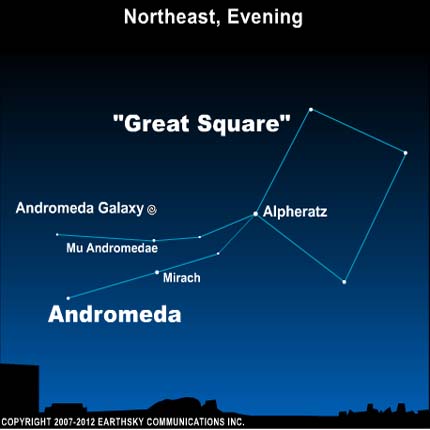 I walked out into my backyard, towards my one remaining pine tree and turned back around to face the east. What a difference a couple of hours makes! I could clearly see the Great Square of Pegasus hovering directly over my roof. In fact, my chimney seemed to be pointing a finger at the famous flying horse. I remembered what I’d read in the EarthSky post about finding the Andromeda galaxy and put what I’d learned to good use. With just a pair of mediocre binoculars, I easily found the smudge that is M31. Now I regretted not moving the XT8 outside before I took my nap.
I walked out into my backyard, towards my one remaining pine tree and turned back around to face the east. What a difference a couple of hours makes! I could clearly see the Great Square of Pegasus hovering directly over my roof. In fact, my chimney seemed to be pointing a finger at the famous flying horse. I remembered what I’d read in the EarthSky post about finding the Andromeda galaxy and put what I’d learned to good use. With just a pair of mediocre binoculars, I easily found the smudge that is M31. Now I regretted not moving the XT8 outside before I took my nap.
I turned ninety degrees to the right and began scanning the southern skies. I can’t see most of the southern horizon, which is blocked by my neighbors tall trees and houses (and all the exterior lighting attached to them). I lose a good twenty if not thirty degrees of sky in all but one direction, to the southwest I can see a bit of horizon, but only through the even worse light pollution generated by the parking lot of a doctor’s office and the streetlights along Main Street (also known as K-7/US-73).
 I needed to find the constellations Aquarius and Capricornus. The ecliptic passes through both of these constellations. Neptune swam the night skies somewhere between the two constellations on the invisible ecliptic course all the planets chart. The trouble in finding Neptune in this area of the sky comes from a lack of bright stars to anchor from for star hopping. I spent the next hour comparing the star atlas from my pocket guide to the stars I saw through the binoculars and eventually convinced myself I had found the southeastern tip of Capricornus. Just above those stars, I believe I found the two brightest stars in Aquarius, Sadalmelik and Sadalsuud, but those two stars were too high above the ecliptic and too far away in the field of view of the binoculars to find Neptune. I needed to do more research and next time use a telescope to help cut through the fog of light pollution.
I needed to find the constellations Aquarius and Capricornus. The ecliptic passes through both of these constellations. Neptune swam the night skies somewhere between the two constellations on the invisible ecliptic course all the planets chart. The trouble in finding Neptune in this area of the sky comes from a lack of bright stars to anchor from for star hopping. I spent the next hour comparing the star atlas from my pocket guide to the stars I saw through the binoculars and eventually convinced myself I had found the southeastern tip of Capricornus. Just above those stars, I believe I found the two brightest stars in Aquarius, Sadalmelik and Sadalsuud, but those two stars were too high above the ecliptic and too far away in the field of view of the binoculars to find Neptune. I needed to do more research and next time use a telescope to help cut through the fog of light pollution.
After an hour, I returned inside and went back to bed, resolved to research better star charts in the morning.
I went back to Astronomy.com and re-read the article on Neptune, but I just couldn’t relate their star chart (shown above) to what I’d observed last night through the binoculars. I would need more magnification and a more steady mount to zoom in and match up the stars shown above to the field of view of the XT8.
 I tried Sky and Telescope’s web page and found a better set of charts in a PDF format in their article about Uranus and Neptune visibility during 2012. I downloaded the document and will print it today to keep with the rest of my star charts.
I tried Sky and Telescope’s web page and found a better set of charts in a PDF format in their article about Uranus and Neptune visibility during 2012. I downloaded the document and will print it today to keep with the rest of my star charts.
Saturdays are always packed full of activities, so I’m hoping I’ll still have the energy tonight to make a second attempt at finding Neptune. My scouting trip showed me what I needed to overcome before I proceed with netting Neptune.
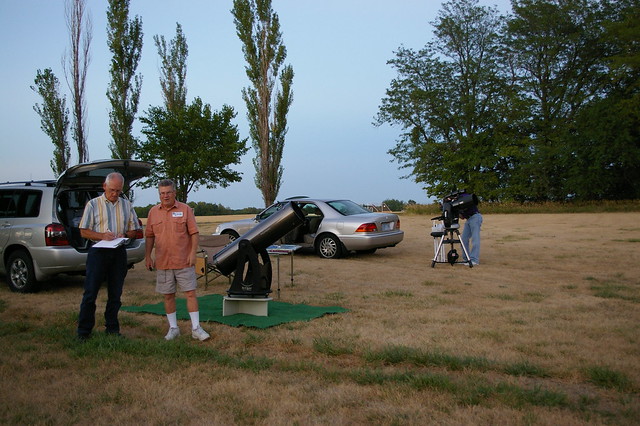
My dad contacted me Thursday to coordinate conveyances for our weekend astronomical adventure, thinking we would be attending the monthly ASKC club meeting, but he was a week early. Since I had mentioned earlier in the week a desire to see the glorious summer spread of our own Milky Way Galaxy, he had called me several times the past few days to see about driving to northern Atchison county to escape the Kansas City area light pollution. Both Wednesday and Thursday evenings turned out to be hazy and cloudy, so we nixed the road trip north.
Instead, I suggested we attend the monthly star party at Powell Observatory. I received two confirmation e-mails from David Hudgins, the club’s star party coordinator extraordinaire. I decided to leave my scope at home because you don’t really need a scope to take in the Milky Way Galaxy. If the skies grew dark enough, it would stretch from the southern horizon, up over the top, clear to the northern one.
I thought perhaps I was reliving last Friday (that would be the 13th) because when I got home early (by ten minutes) I walked into some surreal drama. I won’t go into the stressful week at work (we’ve all had weeks like that), but I looked forward to forgetting work and ignoring the excessive heat by reading books and watching movies in a quiet, air conditioned home with my hubby and two Rotties. I came home to find our satellite on the fritz and Terry needing me to pickup a prescription before the pharmacy closed at seven. While he cooked dinner, I did some preliminary troubleshooting of the satellite system with little success and decided to call DirecTV customer service, knowing I’d probably be on hold for several minutes. The technician wanted us to disconnect, check and reconnect all of our cables, which seemed a ridiculous request since the cable runs are static and have not been touched, moved or manipulated in years. After almost ruining supper in an effort to jump through DirecTV tech support hoops, we hung up on them and sat down to eat.
By now, I had less than an hour to pickup the prescription, so I grabbed my purse and drove to the store. I got as far as the pharmacy counter, where the assistant recognized me and had the prescription ready for me, but when I opened my purse, my billfold was missing. I had left it in the van because I stopped at Starbucks after work for a mocha frappacino treat for the drive home. Now I had to return home for my billfold and repeat the trip back to the pharmacy, a wasted trip, time and gas. When I returned home the third time, Terry had solved the satellite system glich. With our excessive heat and drought conditions, the ground supporting our satellite dish pole has dried up so far down into the ground, that the pole can now be easily moved back and forth and twisted on it’s concrete base. One of our dogs could have bumped into it and messed up the alignment. Terry used the signal strength meter diagnostics channel on the satellite receiver to dial the dish back in.
Hoping that would be the final challenge of the week solved for the moment, I called Dad just after seven o’clock and told him to head my way. I gathered up my camera equipment, my pocket star atlas, a large hardcover edition of Backyard Astronomy (to review Milky Way info), my purse (with billfold) and a lidded glass of cool water. I asked Dad to drive this weekend, volunteering to drive next weekend for the July club meeting. The hour jaunt to Louisburg passed quickly and we arrived at Powell just moments after sunset. The evening cooled off nicely, but remained calm, clear and surprisingly dry. In fact, we experienced no dew (the bane of telescope optics) until after midnight.
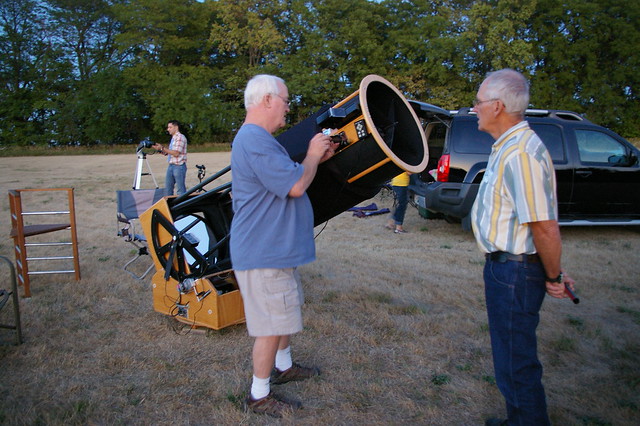
Several club members were already present and setting up their scopes in the East Observing Field (click photo above for photos taken upon our arrival). One member, Mike Sterling, introduced himself to me (asking if I was ‘the’ Jon Moss … apparently my name is known, if not my face or gender, from my blogging). He was in the process of collimating his 20-inch Dobsonian. My dad provided an extra pair of eyes to help finish. Mike also gave us a color brochure published by Astronomy magazine of the illustrated Messier catalog. This will come in handy in the future when I really get serious about an observing award.
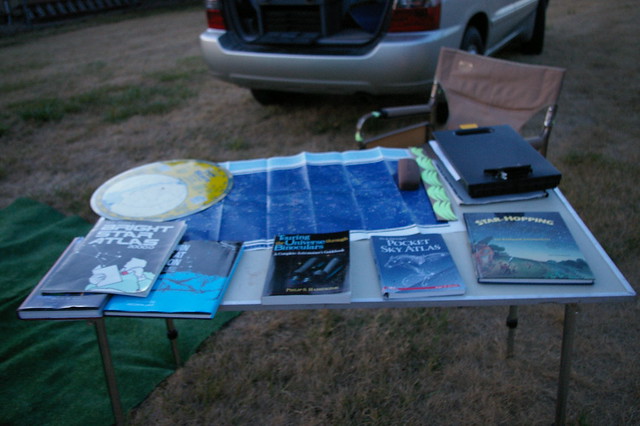
The theme for this month’s star party centered around star charts and atlases. David Hudgins setup a table displaying several popular and easy-to-use books, visual aids and posters. I indicated to David I already owned the Sky & Telescope Pocket Sky Atlas and a smaller version of the wheel night sky star guide (the circular atlas resting on top of the poster in the upper left hand corner of the table shown in the photo above).
Dad and I wondered among the scopes, waiting for twilight to fade and the stars to emerge. Saturn and Mars, along with Spica and Arcturus appeared very early and most of the scopes honed in on our ringed neighbor. By 10:30 pm, the skies had darkened enough to begin hunting for some of the brighter Messier objects. Mike graciously asked me (several times over the course of the evening) what I wanted to observe next. I drew a blank every time because my goal had been to see the Milky Way, not any specific object viewable in a scope. He obligingly filled in the blank by touring through clusters, nebulae and a galaxy found in the constellation Sagittarius, Scorpius, Hercules and Ursa Major. I tweeted the objects as we found them so I would have a record of what we saw and when.
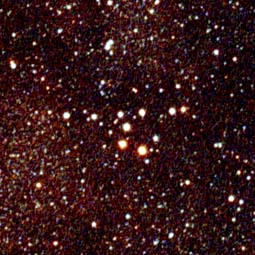
My dad and I also used his binoculars just to see what we could see with them (as opposed to a scope). The highlight of that side project included finding Brocchi’s Cluster (more commonly known by the asterism ‘the Coathanger’). One of the other club members used the Summer Triangle as an aid to locating the Coathanger. As stated in the Wikipedia article: “It is best found by slowly sweeping across the Milky Way along an imaginary line from the bright star Altair toward the even brighter star Vega. About one third of the way toward Vega, the Coathanger should be spotted easily against a darker region of the Milky Way. The asterism is best seen in July-August and north of 20° north latitude it is displayed upside down (as in the picture above) when it is at its highest point.”
* Update * (added after original publication):
I completely spaced out tweeting during the eleven o’clock hour. During this time, Mike disconnected the Goto electronics on his telescope and set me to star hopping for objects near Sagittarius. The first one he tested me with was finding two small globular clusters a small hop away from the gamma star in Sagittarius (the star the delineates the spout of the teapot). If I could find these two clusters, Mike told me I should be able to see both of them at the same time in the eyepiece’s field of view. After about five minutes, I spied a couple of small fuzzy balls, not as distinct as the surrounding background stars, but I thought they might be the clusters. Mike confirmed I had found them by doing a ‘happy dance’ and sing-songing ‘she found them, she found them’ for all to hear. The designations for these clusters are NGC 6522 and 6528.
Mike next set me to finding either M69 or M70 (also hanging out in Sagittarius, but in the bottom of the Teapot). I glanced at his star chart and used his excellent Telrad finderscope (which had a nice large field of view and an easy-to-use red bullseye) to quickly locate one of the Messier objects (probably M69). Again Mike did a happy dance and song.
Mike went looking for another globular cluster, this time between Sagittarius and Scorpius, designated as NGC 6380. I found this one especially interesting because of it’s apparent close proximity to a star.
The third test proved my undoing. Mike moved his scope to Antares in Scorpius and set me to finding M4. I didn’t review his star chart and spent several minutes attempting to find it. Eventually, I gave up and Mike located it.

Despite all the mesmerizing Messier distractions, I did succeed in observing the vast sweep of our Milky Way Galaxy. I learned a couple of cool memory aids and bits of trivia about finding the ‘heart’ of the galaxy and the path it takes. Cygnus, the swan constellation, also sometimes known as the ‘Northern Cross,’ flies along the Milky Way, pointing directly to the heart of the galaxy. To find the Milky Way’s heart, locate the Teapot (an asterism for the constellation Sagittarius), visible along the southern horizon during July and August, and imagine steam rising from the spout.
I even attempted to photograph the Milky Way using my simple tripod and DSLR camera, but without an equitorial mount of some kind with a tracking system and the digital photo editing software (to stack multiple repetitive exposures), the best I could accomplish was a three or four second exposure (using ISO 800) and fiddling with the brightness/contrast after downloading:

I also took photos of Cygnus swimming in the Milky Way, the Summer Triangle, the Big Dipper over the dome of the observatory and several of the southern horizon. To see the entire album, click on the photo at the top of this blog.
Soon after 12:30 a.m., Dad and I thanked Mike Sterling for the guided tour of the summer sky. We packed up our gear and drove the hour home, where I finally drifted off to sleep after two o’clock with visions of Messier objects dancing in my head.
Dad and I had a blast and my husband is now having second thoughts about staying home last night. Many thanks to David Hudgins, Mike Sterling and the other members of the Astronomical Society of Kansas City for throwing a fun mid-summer star party.
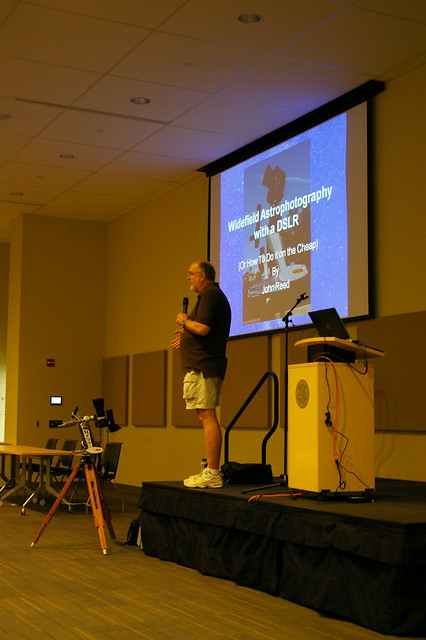
After a handulf of hours sleeping, I drug myself out of bed early Sundy morning. Rather than eating breakfast, I composed my blog post recapping Saturday at the MSRAL convention. I published at ten after eight o’clock, leaving me less than an hour to drive to UMKC from Lansing. The last day of the convention consisted of a morning dedicated to three workshops. Not knowing what I might need, I packed up my laptop and my DSLR camera and zipped down I-70, arriving with about ten minutes to spare.
I burdened myself with my laptop bag, camera backpack, purse and water bottle and trudged up the stairs to the Student Union. I opted not to take the additional four flights of stairs on the interior of the building, taking full advantage of the elevator to the top floor. I planted myself on the first row (as I’ve done each day of the convention) so I wouldn’t have any trouble hearing or seeing (or taking photographs like the one above).
Very interesting workshop on using consumer camera equipment (a Canon DSLR and a 200 mm telephoto with an AstroTrac mount) and some post-production work with Photoshop for stunning astrophotography.
The middle workshop presented by Jim Roe dealt with variable stars and doing some hands on scientific observation and research. I got to know his old friend Z Umi (a variable star in the Little Dipper).

The final workshop of the day got really hands on, for those who wanted to participate in the step-by-step process of massaging web cam videos taken of Saturn to produce a nice crisp stacked image. The entire presentation will be uploaded to David’s website (Sunflower Astronomy) in the near future.
I learned so much and met some great people. I have many fascinating ideas and concepts revolving through my brain and many new projects I’m inspired to pursue. I look forward to attending similar conferences when they pass through the area again.
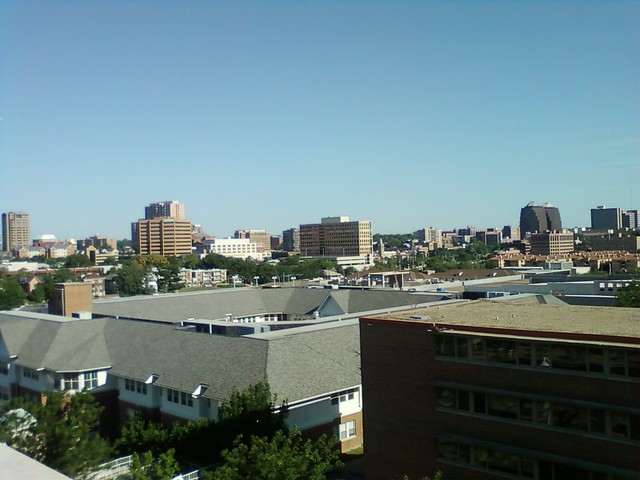
I survived the second day of the MSRAL convention. I think I overdosed on science, as my brain worked overtime while I slept to process the fascinating concepts, breakthroughs and forthcoming projects in astronomy and astrophysics I absorbed Saturday.
I arrived just in time to wait for the business meeting (scheduled for the eight o’clock hour) to run over into the first session. I strolled around the fourth floor of the UMKC Student Union, watching the venders setup their tables in the room adjacent to the main conference one. Several conference attendees also brought their solar telescopes and began setting them up on the rooftop deck of the building to facilitate solar observing throughout the entire day (and we had crystal clear skies for the duration).
Morning sessions:
I returned to the stairs leading from the third floor to the top floor of the Student Union for the group photo just before we broke for lunch. I ended up standing in the second row directly behind Fred Bruenjes (see local comet discoverer mentioned above).
Afternoon sessions:

Evening Keynote: LSST by Dr. Barbara Anthony-Twarog. Wow, just wow. This telescope, when it becomes operational (currently proposed completion and operational in 2022), will survey the sky like never before. All the data (15 terabytes per night) will be freely available to everyone (not just the US public, but the entire world). By the time it finishes its ten year run, there may be nothing left for traditional observers (both professional and amateur astronomers alike) to discover. The future of astronomical research will no longer rely on observations, but will need computer scientists and data miners to sift through the avalanche of data produced by the LSST.

After Dark: Warko on the rooftop of Royall Hall
I moved my vehicle from the parking lot next to the Student Union to the parking garage next to Royall Hall, parking on the fourth level to take the sky bridge across to the building and then a couple of flights of stairs up to the rooftop observatory. The nearly full moon shone exceptionally bright on a clear, calm evening. We trained the 16 inch telescope on it, at least until the sky darkened enough to move on to other targets. I snapped a quick photo with my cell phone of the bright moon through the eyepiece:
We moved on to Saturn and stayed there until I had to leave (around 10:30) because I had a forty minute drive home and had been up since five.
I saw my first iridium flare last night. What is an iridium streak, you ask? Check out the Heavens Above web page to find out and to search for a streaker in your neighborhood (sky that is).
I enjoyed my second day at the convention. I learned more than I can possibly absorb on just five hours of sleep. In just a few minutes, I return for the final half-day of workshops. I’ll post my final thoughts later this afternoon, perhaps after I’ve had a nap.

Even though Friday dawned overcast and gloomy, by noon, I could see bits of blue among the dissolving puffs of grey and white. I received an early confirmation e-mail from ASKC announcing the ‘go live’ time for the astronomy club’s star party at Powell Observatory in Louisburg, Kansas. I had already invited Dad to come as my guest and not only because Terry already had plans. The weather forecast predicted clear skies, but cold temperatures, reaching mid-40s by midnight on the observing field.
I left work at the usual time and retrieved all my riders, returning them safely home without delay. Not even the race activities at the Kansas Speedway slowed me down when I dropped off my first rider, who lives within spitting distance of that facility. We all could hear the cars racing around the track, not for a race, but more likely for practice or qualifying.
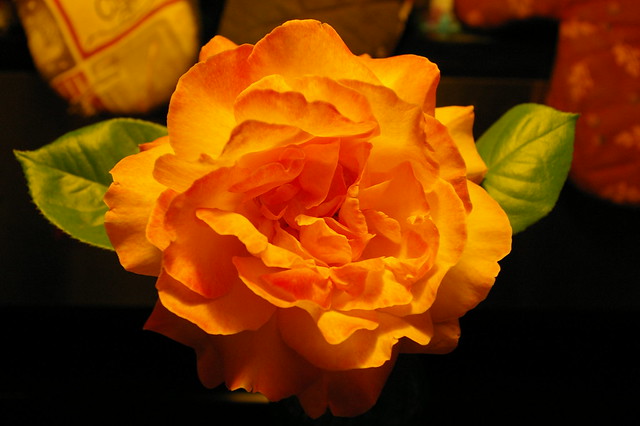 I got home and realized I had forgotten to print a map with directions from Lansing to Louisburg and wrangled Terry into printing one for me. While I was waiting on the printout, my Dad arrived, bringing me a beautiful rose from his garden. He placed it smack dab in the center of my table, but I didn’t notice it until I knocked over the vase with my camera bag. Then, I mistakenly thought Terry had stolen a rose from one of our neighbors. Dad had a hard time not laughing himself silly, especially since he tried to let Terry take the credit for the impromptu flower appearance. I thanked Dad for the gift while I mopped up the spilled water with a spare towel.
I got home and realized I had forgotten to print a map with directions from Lansing to Louisburg and wrangled Terry into printing one for me. While I was waiting on the printout, my Dad arrived, bringing me a beautiful rose from his garden. He placed it smack dab in the center of my table, but I didn’t notice it until I knocked over the vase with my camera bag. Then, I mistakenly thought Terry had stolen a rose from one of our neighbors. Dad had a hard time not laughing himself silly, especially since he tried to let Terry take the credit for the impromptu flower appearance. I thanked Dad for the gift while I mopped up the spilled water with a spare towel.
I changed clothes, grabbed a sweater with a hood, my scarf, my gloves, a gallon of water, my water bottle, my camera bag and tripod and my purse. Dad already had the rest of the gear in his trunk. We rolled south out of Lansing by a quarter to six. We stopped briefly in Bonner Springs for a quick supper and continued down K-7 to Shawnee Mission Parkway, then to I-435 and eventually US-69. Louisburg is less than twenty miles south of Overland Park, so once we rounding the curve where I-35 crosses I-435 (where the mile markers for I-435 start at zero (0) and end at eight-three (3), we had less than a half hour of driving to reach the observatory. We pulled into the park just a bit after seven o’clock in the evening.
The star party organizer for the ASKC was already on site. He greeted us and we all began debating where to setup on the observing field around Powell. He was concerned about a baseball game or practice that appeared to be occurring on a ball field just northwest of the site. He drove over and asked the participants if they planned to turn on the field lights. He returned to confirm the lights would be on until 9:30 p.m. Thus, all of us decided to setup on the east side of the Powell Observatory building, letting it block the lights to help protect our night vision.
Dad and I unpacked the gear and hauled it across the observing field to a spot just southeast of the dome. I setup my camera and tripod to take a couple of photos of the sunset.
As predicted, the lights lit up the field, and competed with the glow of Kansas City sufficing the northern horizon. Dad and I waited patiently (him more than me) for enough stars to pop forth to attempt an alignment of the telescope. While we waited, I took a few more photos of the western horizon, mostly to capture the very bright Venus.
Soon after we spotted Venus, Sirius made its appearance in the southwestern sky. Once Arcturus crested over the trees in the northeast, we used both those stars for an alignment of the ETX-90 via the Autostar device. We did a quick tour of the four visible planets, starting with Venus. Even though Venus is a thinning crescent (as it moves towards us and between the Earth and the Sun), it is almost too bright to look at. Without adding a filter to the eyepiece, I couldn’t look directly at it for more than a few seconds. Next we caught Jupiter before it set in the west. I spotted all four moons, but only for the first few minutes. As it sunk closer and closer to the horizon, the haze and humidity obscured all but the planet itself from visibility.
Next we swung the telescope back to the southeast, but nearly directly overhead (about ten or eleven o’clock above us) to view Mars. While I debated internally what higher magnification eyepiece to insert, the star party organizer joined Dad and I at our telescope. He commented that he had owned a similar scope in years past and affirmed it was a good scope for planetary and lunar observing. He took a quick look through the eyepiece at Mars and moved on to the next person on the field. One of my goals for the evening was to decide if the small ETX-90 would allow me to view any deep sky objects (galaxies in particular).
Our final planetary tour stop landed on Saturn, which crested over the trees soon after we finished observing Mars. I easily found Titan, Saturn’s largest moon, but could not discern the gap(s) between the rings, even after adding the two times Barlow to the 25mm eyepiece I prefer to use.
Orion had his left foot on the western horizon as I swung the scope back to the southwest for a quick peak at the Great Orion Nebula. As far as I could tell, it looked similar to what I had seen from my back yard in late March. At that time, Orion’s Sword appeared much higher in the sky and I looked through less atmosphere (but had more light pollution in Lansing). But the combination of less light, yet more atmosphere gave me basically the same observing experience.
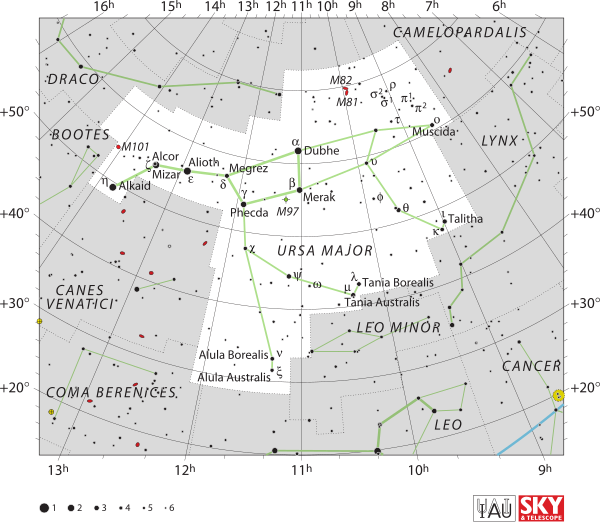
At this point, I took a break to spare my aching feet and sat in one of the chairs Dad had brought along. The north wind had died off by this time, but I couldn’t seem to get my toes enough circulation. The rest of me, my head, hands, upper body and legs, were fine. But my toes continued to be a distraction and eventually a source of chilling pain. I used my red flashlight to review several star charts in my pocket sky atlas, searching for a deep sky object that would be (hopefully) visible via my small scope. I settled on the Whirlpool Galaxy found near the first star (Alkaid) in the handle of the Big Dipper. As you can see in the chart above, just below and to the right of Alkaid is where you should find the Whirlpool Galaxy. Even with a red dot viewfinder to help, neither Dad nor I could locate the galaxy. It only has a magnitude of 8.4, and I fear the increasing glow from Kansas City to our north and the rising humidity as the temperature dropped to the dew point conspired against our efforts.
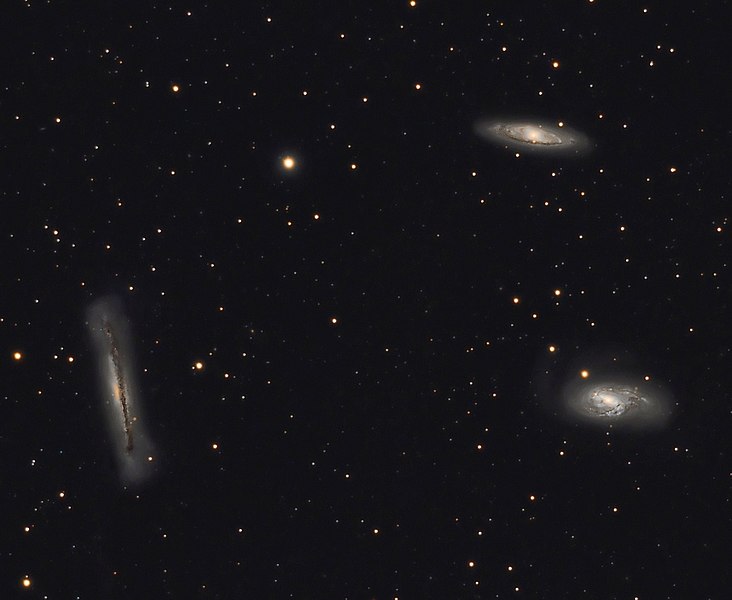
Before I could pick up my pocket sky atlas to find some other deep sky object to try, the star party organizer returned, asking us if we wanted to see the Leo Triplet, three galaxies visible all at the same time. While not as clear as the photo at the left, I did see all three galaxies through his telescope in one field of view. Amazing! Once I returned to my scope, I directed it to find Mars (which still hovers near Leo) to confirm the alignment and then told it to find M65 (one of the two galaxies on the right hand side of the photo above. I believe I saw a grey smudge or two, but not the third fainter elongated galaxy (on the left above). Since Leo still appeared directly overhead, and Louisburg to the southeast does not sport nearly as much light as Kansas City to the north, I had good conditions for seeing such faint objects (magnitude 9 and 10).
At this point, I could barely stand on my aching chilled feet any longer. I sat for a few minutes, letting my eyes wonder around the sky in hopes of seeing a few meteors. I did see two. I asked Dad if there was anything else he wanted to observe. I think he returned to Saturn for a final look at the ringed giant. After that, we dismantled the equipment and packed it back up (all in the dark with a dying red flash light). We made several trips across the observing field to the car.
As Dad started up the car (and I turned the heat for the passenger side all the way up to red hot), the clock on the dash flashed 11:00 p.m. We pulled out of the parking lot with only our parking lights on (to minimize light for those still observing) and stopped at McDonalds so I could buy a mocha. All three convenience stores in Louisburg had closed (not extremely convenient for us obviously). We retraced our route up US-69, through Overland Park, to I-435 and took Parallel Parkway back to K-7 and arrived back in Lansing just after midnight.
After this excursion, I believe I need to start saving my pennies for an upgrade. I still plan to use the ETX-90 to observe the Transit of Venus. The small scope is actually a boon for observing our closest star, Sol and our sister planet, Venus. I just need the solar filter film, currently on back order, to prevent damage to my eyes and the scope.
Thanks to the Astronomical Society of Kansas City for hosting the star party. Dad and I had an enjoyable evening.
 Much of my March will revolve around Mars. For example, this Saturday, March 3rd, according to Sky & Telescope‘s ‘This Week’s Sky at a Glance‘ (both for this past week and the one ahead), Mars shines highest in the south, in the sharpest telescopic view, around midnight.
Much of my March will revolve around Mars. For example, this Saturday, March 3rd, according to Sky & Telescope‘s ‘This Week’s Sky at a Glance‘ (both for this past week and the one ahead), Mars shines highest in the south, in the sharpest telescopic view, around midnight.
Mars is at opposition, appearing opposite the Sun in Earth’s sky. This is the most distant opposition of Mars in its 15-year cycle of oppositions near and far, so the planet appears only 13.9 arcseconds wide. At its next time around in April 2014, Mars will reach a diameter of 15.2″.
My goal is to stay up late enough on Saturday night to allow the moon to set (or almost set) and Mars to be either directly overhead or just over the top and falling towards the western horizon. That will optimize my viewing, reducing the amount of atmosphere I must look through and minimizing the effect of the light pollution in my area.
For this first weekend of March, I think I will limit myself to my own backyard. I did receive the new power cord I ordered for the ETX-90 yesterday, so I will test that out tonight with the portable battery pack my father reconditioned and gifted to me. The following weekend will present more difficulties observing Mars since the Full Moon will be two days old on Saturday the 10th.
 Just a day or two after the vernal equinox I hope to join other members of the Astronomical Society of Kansas City (ASKC) in the annual Messier Marathon – an attempt to find as many Messier Objects as possible during one night. Since the new moon occurs just two days after the equinox, my only concern would be clouds to obscure an otherwise perfect dark night sky. I don’t plan on needing a tent, since I wouldn’t be sleeping until the sun broke over the eastern horizon anyway. I will really regret giving up drinking tea and coffee (or any kind of beverage except water) for Lent during that long night. I just hope the excitement of discovery will keep me awake.
Just a day or two after the vernal equinox I hope to join other members of the Astronomical Society of Kansas City (ASKC) in the annual Messier Marathon – an attempt to find as many Messier Objects as possible during one night. Since the new moon occurs just two days after the equinox, my only concern would be clouds to obscure an otherwise perfect dark night sky. I don’t plan on needing a tent, since I wouldn’t be sleeping until the sun broke over the eastern horizon anyway. I will really regret giving up drinking tea and coffee (or any kind of beverage except water) for Lent during that long night. I just hope the excitement of discovery will keep me awake.